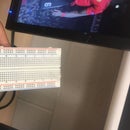Introduction: WEATHER SHAZAM
Hello my name is Sushant Joshi and welcome to my Instructable / FINAL PROJECT. This project showcases my Final project for my Engineering Grade 11 Course. It will go through all the materials needed to make, all components, how to build it ( Circuitry ), the code of the project, and how to make it look nice! A basic overview of this project is basically a Weather Simulator ( I call it Weather Shazam ). It has a Humiture Detector, which detects humidity and temperature, a flame alarm with a buzzer, so if there is fire, it would make a loud noise, there is a water sensor which detects if there's too much water, and finally a gas sensor to see if there's a abundance of CO2. This all displays on the LCD.
Supplies
SUPPLIES NEEDED:
BREADBOARD
ARDUINO UNO
JUMPER WIRES
FEMALE FEMALE WIRES
MALE MALE WIRES
CARDBOARD AND TAPE ( ELECTRICAL )
1 X LCD SCREEN
1 X GAS SENSOR
1 X HUMITURE SENSOR
1 X FLAME ALARM
1 X BUZZER
1 X WATER SENSOR
1 X PLANT
1 X LIGHTER
WATER
Step 1: Preparation of Each Sensor
LCD SCREEN PREPARATION
For this component first off you need to connect the LCD Screen to ground and power ( Either on the Arduino or the breadboard with jumper wires )
Then you need to connect the ports of LCD to Analog Pins A4 and A5 ( Green wires in the first picture for LCD)
WATER SENSOR PREPARATION
This ones quite simple, you connect the power and ground ( + and - on the sensor ) into their sections, then for the last port, connect it to Analog Pin A1.
HUMITURE SENSOR PREPARATION
For this one, connect the first and last port ( As shown in the fifth picture of Humidity ) connect them to power and ground appropriately, and then connect the middle port to Digital Pin 7.
GAS SENSOR PREPARATION
This sensor, connect power and ground respectively once again, then connect to the Analog Pin to A2
FLAME ALARM PREPARATION
So first of all connect power and ground ( A Common Trend ), then connect to Analog Pin to A0 and Digital Pin 8.
BUZZER PREPARATION
Connect the negative side of the Buzzer to ground and the other pin to Digital Pin 6.
Step 2: Putting the Code Together
So the code is mainly self explanatory but I will go through the basics of the code to portray the most important bits.
The beginning:
Remember to always add the libraries in your system ( Or at least your Arduino Folders )
The specific Libraries that are needed are:
Wire.h
LiquidCrystal_I2c.h
dht.h
These specific libraries are needed to fulfill the code and make it work, without them, the code is useless.
Another important thing I wanted to mention is the inputs and to make sure to state all the digital pins and analog pins
#define FLAME 6
#define BUZZER 6
dht DHT;
const int DHT11_PIN= 7;
const int waterSensor = A1;
int waterValue = 0;
int gas;
int water;
These things are important and crucial for the code to work.
Also while writing the code make sure to properly put the brackets needed and also the proper if statements, follow along with the pictures.
Step 3: Make It Look Nice !
This is not mandatory , but it is going the extra mile to make it look nice and tidy
To make this type of house / box, you can do it your own way but for mine. all you have to do is:
- Find a random box in your house
- Cut it into pieces and use tape to stick together
- Cut holes for each Individual Component
- After doing this and putting some work , you'll have the first picture
- Then put your breadboard and Arduino in your box
- Make a door for it as shown on the second picture
- Refine it and make it look even better
- Add final touches and decorations
- You're finished!
Now enjoy the weather simulator and have fun.









